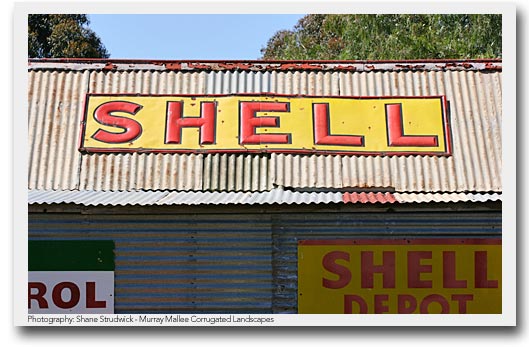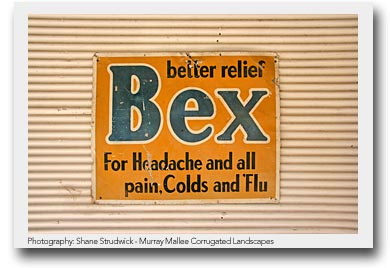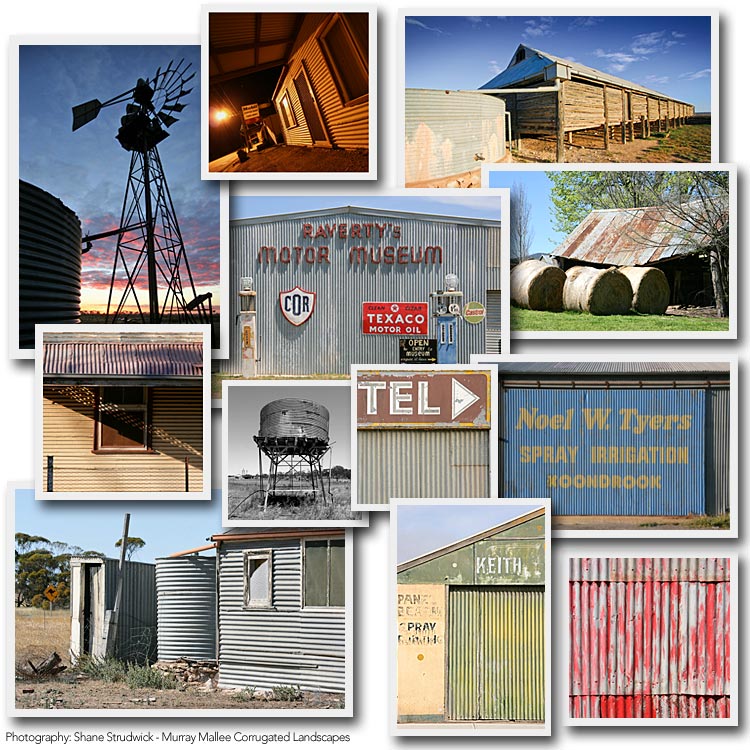
Australia's identification with corrugated iron

Printed with permission of Australia Post
For more information on new Australian stamp issues visit: www.auspost.com.au/stamps
A vernacular tradition
Australia's identification with corrugated iron
Australia is, beyond any doubt, the spiritual home of corrugated iron.*
Why do we consider corrugated as our own, to the extent that it was a star in the "Tin Symphony" at the closing ceremony of the Sydney Olympics? One may speculate about the reasons - the memory of the sound of rain on a tin roof resonates for many - or take a cue from artists and architects who have interpreted its history and exploited its associations.
Commenting on the unfolding spectacle of the "Tin Symphony", a TV journalist described the corrugated iron sheets as "the building material which made the bush" Corrugated iron indeed played a strong role in the settling of Australia. As a material of the industrial and colonising age, it has been a crucial part of our frontier and mining adventures. We associate it with distinctively Australian buildings such as "the Queenslander", with its steeply pitched roof clad in corrugated iron; the shearing shed; the woolshed; the outdoor dunny; and the ubiquitous water tank that is essential to our country's development and survival.
Corrugated iron is readily transported across vast distances, and can be reused when temporary structures outlive their purpose. It suits harsh natural conditions where practical improvised solutions are needed.
It has long been used by Indigenous Australians, who adapted traditional shelters such as windbreaks and humpies by using introduced materials such as corrugated iron, "the white man's bark". Their profound understanding of the environment has in turn inspired the recent revival of corrugated iron, which modern architects have used to emulate the Aborigines' "light touch" upon the land. Aside from its economy and versatility, the rusted, weathered forms of corrugated iron seem to evoke a blend in particularly well with the hues and textures of the Australian landscape.

What is corrugated iron?
Manufacturing then and now
Corrugated iron - which despite its name is now always made of steel - is metal crimped so as to greatly increase its strength. It is cheap, durable, light and strong, flexible, fixable, reusable and easily transported - this versatility is the key to its varied and continuing use.
In the nineteenth century wrought iron was often galvanised with zinc to prevent rust, hence the alternative name "galvanised iron". Today a similar product, Zincalume™, has a coating made from a combination of aluminum, zinc and silicon. Since the 1960s plastic coatings have been applied to sheet steel as an additional protective device and as a means of achieving a durable colour finish. These multi-hued corrugated surfaces are as common in our new industrial and suburban landscapes as rusted iron is a feature in the bush.
Corrugated iron is a product of industrial and imperial Britain, where it was invented and patented in 1829. From about 1850 it appeared as a building material in Australia, and by the mid-1880s Australia had become Britain's largest customer. Local production facilities were begun by BHP at Newcastle in 1915 and at Port Kembla in 1939.
By the late 1970s BHP (now BlueScope Steel) had taken over John Lysaght (Australia) and in 2000 was the sole producer worldwide of Zincalume™. Australia has since become a major steel exporter, specialising in metallic coating and painting technologies. BlueScope Steel's major brand Lysaght™ reveals it legacy in nineteen-century production.

Iron and gold
The gold rush in Victoria was the major catalyst for the importation of corrugated iron in Australia. There was a demand for speedy construction and the flexible, lightweight, cheap corrugated iron was well-suited to this purpose. From about 1850 it arrived from England as a building material, as roofing for verandahs and in the form of portable shops, sheds and churches. It was used to make vast numbers of prefabricated dwellings to house colonial settlers, miners and other workers.
The expanding demand for corrugated buildings during the gold rush led manufactures to expand their product range and to promote their wares in advertisements. Samuel Hemming's lithography depicts an entire town of buildings made in corrugated iron - its style in marked contrast to stone edifices that were soon to flaunt Melbourne's wealth. He was said to have established his business after successfully constructing a portable house for a son who emigrated to Australia. In 1853 Hemming was contracted to supply the Diocese of Melbourne with several iron churches, each of which was stored in 60 packing cased in St James's churchyard. One was purchased by the Episcopalian Church in Gisborne for £1000, where it was carted by bullock wagon and erected for a further £500, and served as a church until 1949.
Corrugated iron in art
Corrugated iron has been used as a material by a number of artists in Australia. Rosalie Gascoigne used weathered corrugated iron to create refined artworks evocative of the Australian landscape, while Jeff Thomson makes corrugated animals that exploit its rustic charms and sculptural malleability. Many other artists and photographers have depicted corrugated iron as it appears within the landscape, such as Russell Drysdale in his iconic paintings of the outback, or Jeffrey Smart in his paintings of desolate urban scenes.
Gascoigne (1917-1999) made her name using corrugated iron an other weathered materials that she identified with a particularly Australian landscape. In her work, the much-loved qualities of corrugated iron become a source of visual poetry.White Garden emphasises the rhythmic pattern of the corrugation and the surface texture of the material, which the artist thought of as "very elegant. And very Australian". Her source of iron for this work "a beautiful white grey tin, marvelous" - was a cowshed at Gundaroo, near Canberra.
In Russell Drysdales painting Emus in a Landscape, scattered sheets of corrugated iron represented a failed attempt to contain or colonise the land - they drift as detritus in a natural world that preceded and will outlive them.
Check out the Riverland's corrugated artist Dudley Siviour

*Adam Mornement & Simon Holloway, Corrugated Iron: Building on the Frontier, p 157.
Tell your friends you found this at murrayriver.com.au!
Copyright Discover Murray 2025. This site or any portion of this site must not be reproduced, duplicated, copied, sold, resold, or otherwise exploited for any commercial purpose that is not expressly permitted by DISCOVER MURRAY.






 The Royal Edinburgh Military Tattoo 2023 - Arts On Screen
The Royal Edinburgh Military Tattoo 2023 - Arts On Screen An Afternoon Of Classical Piano
An Afternoon Of Classical Piano CREEDENCE CLEARWATER COLLECTIVE
CREEDENCE CLEARWATER COLLECTIVE Big Band Christmas Bash 2023
Big Band Christmas Bash 2023